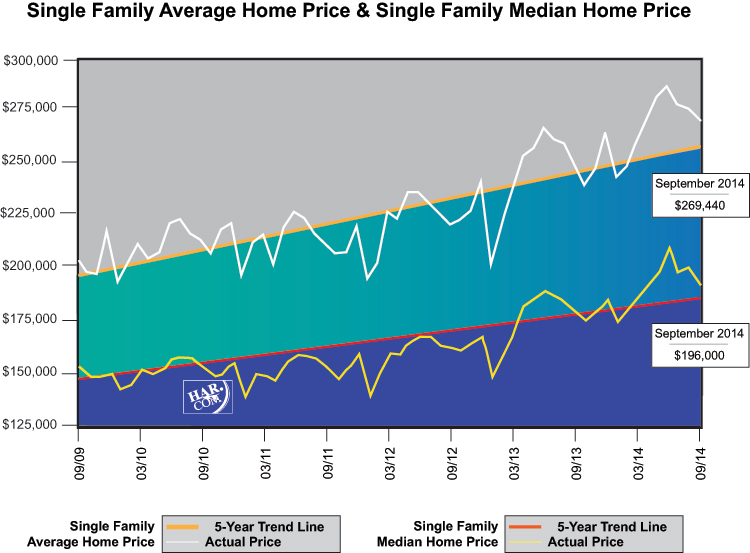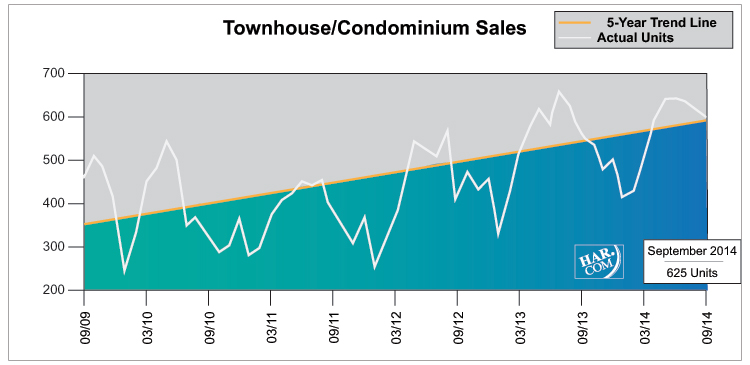MLS Report for September 2014
HOUSTON HOME SALES SHOW NO SIGN OF LET-UP IN SEPTEMBER
Inventory shrinks slightly and prices climb as the home buying frenzy continues
HOUSTON — (October 8, 2014) — The
fall home buying season began with gusto in Houston as sales and prices
did in September what they have done for months – rose. The continued
buying frenzy caused housing inventory to shrink very slightly after
holding steady for two consecutive months. And in another scenario that
has become all too familiar in this market, prices reached record
one-month highs.
According to the latest monthly report prepared by the Houston
Association of Realtors (HAR), single-family home sales totaled 6,490
units, an increase of 7.0 percent compared to September 2013. Months of
inventory, an estimate of the time required to deplete the current
active housing inventory based on the previous 12 months of sales
activity, dipped to a 2.9-months supply from a 3.2-months supply last
September. It remains well below the current national supply of 5.5
months of inventory.
The average price of a single-family home jumped 8.2 percent
year-over-year to $269,440. The median price—the figure at which half
the homes sold for more and half for less—rose 7.7 percent to $196,000.
September sales of all property types totaled 7,879 units, a
7.0-percent increase compared to the same month last year. Total dollar
volume for properties sold soared 15.7 percent to $2 billion versus $1.7
billion a year earlier.
“As long as consumers continue to snap up homes at the current
pace, replenishing our housing inventory will be a slow process,” said
HAR Chair Chaille Ralph with Heritage Texas Properties. “Rental numbers
were strong in September, suggesting that many would-be home buyers are
continuing to go the lease route until the market bears the homes
they’re looking for at the price point that suits them.”
September Monthly Market Comparison
The Houston housing market experienced across-the-board gains in
September, with total property sales, total dollar volume and average
and median pricing all up when compared to September 2013.
Month-end pending sales for all property types totaled 4,143. That is
up 17.2 percent compared to last year and is considered a bellwether of
continued positive sales activity next month. Active listings, or the
number of available properties, at the end of September was 28,946 and
is 10.8 percent below last year.
Houston’s housing inventory, after holding steady at a 3.0-months
supply in July and August, shrank in September to a 2.9-months supply
versus 3.2 months a year earlier. That compares to a 5.5-months supply
of inventory across the U.S. recently reported by the National
Association of Realtors.
| CATEGORIES |
SEPTEMBER 2013 |
SEPTEMBER 2014 |
CHANGE |
| Total property sales |
7,362 |
7,879 |
7.0% |
| Total dollar volume |
$1,733,076,889 |
$2,005,556,946 |
15.7% |
| Total active listings |
32,457 |
28,946 |
-10.8% |
| Total pending sales |
3,536 |
4,143 |
17.2% |
| Single-family home sales |
6,064 |
6,490 |
7.0% |
| Single-family average sales price |
$248,948 |
$269,440 |
8.2% |
| Single-family median sales price |
$182,000 |
$196,000 |
7.7% |
| Single-family months inventory* |
3.2 |
2.9 |
-10.0% |
* Months inventory
estimates the number of months it will take to deplete current active
inventory based on the prior 12 months sales activity. This figure is
representative of the single-family homes market.
Single-Family Homes Update
September single-family home sales totaled 6,490, up 7.0 percent from September 2013.
Home prices reached record highs for a September in Houston. The
single-family average price increased 8.2 percent from last year to
$269,440 and the median price climbed 7.7 percent year-over-year to
$196,000. Transactions continued to close at a near-record pace. The
number of days a home took to sell¬, or Days on Market, was 47. In July
it reached a record low of 45 days.
Broken out by housing segment, September sales performed as follows:
$1 - $79,999: decreased 20.7 percent
$80,000 - $149,999: decreased 8.8 percent
$150,000 - $249,999: increased 10.2 percent
$250,000 - $499,999: increased 16.5 percent
$500,000 - $1 million and above: increased 26.7 percent
HAR
also breaks out the sales figures for existing single-family homes. In
September, existing home sales totaled 5,715. That is up 10.2 percent
from the same month last year. The average sales price increased 6.8
percent year-over-year to $250,966 while the median sales price jumped
7.5 percent to $182,800.
Townhouse/Condominium Update
After
two months of declines, sales of townhouses and condominiums rose 7.4
percent in September versus one year earlier. A total of 625 units sold
last month compared to 582 properties in September 2013. The average
price increased 7.5 percent to $195,064 and the median price shot up
10.7 percent to $150,500. Inventory reached to a 2.5-months supply
versus a 3.1-months supply a year earlier.
Lease Property Update
Lease
properties showed strong demand in September as inventory of for-sale
properties remained tight. Single-family home rentals soared 13.2
percent compared to September 2013, while year-over-year
townhouse/condominium rentals increased 8.8 percent. The average rent
for a single-family home was up 2.7 percent to $1,749 and the average
rent for a townhouse/condominium was flat at $1,533.
Houston Real Estate Milestones in September
- Single-family home sales rose 7.0 percent versus September 2013;
- Total property sales were up 7.0 percent year-over year;
- Total dollar volume climbed 15.7 percent, increasing from $1.7 billion to $2 billion on a year-over-year basis;
- At $196,000, the single-family home median price achieved a record high for an September;
- At $269,440, the single-family home average price also reached an September high;
- Days on Market for single-family homes was 47, slightly above July’s record low of 45 days;
- Rentals of single-family homes shot up 13.2 percent year-over-year
and the cost of renting those homes increased 2.7 percent to $1,749.
- Townhouse/condominium rentals rose 8.8 percent, with rents flat at $1,533.
The computerized Multiple Listing Service of the Houston Association
of REALTORS® includes residential properties and new homes listed by
29,000 REALTORS® throughout Harris, Fort Bend and Montgomery counties,
as well as parts of Brazoria, Galveston, Waller and Wharton counties.
Residential home sales statistics as well as listing information for
more than 50,000 properties may be found on the Internet at
http://www.har.com.
The information published and disseminated to the HAR Multiple Listing
Services is communicated verbatim, without change by Multiple Listing
Services, as filed by MLS participants.
The MLS does not verify the information provided and disclaims any
responsibility for its accuracy. All data is preliminary and subject to
change. Monthly sales figures reported since November 1998 includes a
statistical estimation to account for late entries. Twelve-month totals
may vary from actual end-of-year figures. (Single-family detached homes
were broken out separately in monthly figures beginning February 1988.)
Founded in 1918, the
Houston Association of REALTORS®
(HAR) is a 29,000-member organization of real estate professionals
engaged in every aspect of the industry, including residential and
commercial sales and leasing, appraisal, property management and
counseling. It is the largest individual dues-paying membership trade
association in Houston as well as the second largest local
association/board of REALTORS® in the United States.











